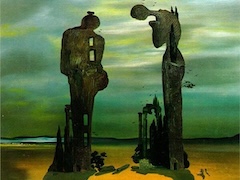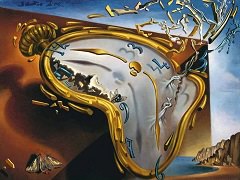Shades of Night Descending, 1931 by Salvador Dali

The brooding atmosphere that dominates the foreground of this painting is heightened by its contrast to the luminous beach scene in the background. Lengthening shadows announce the approach of the formless night; the silence of the work is disquieting. These evocative attributes are notable in the work of Giorgio de Chirico, so admired by Dali and all the Surrealists, especially the sense of foreboding, the silent, suspenseful mood, captured by the long, raking shadows in his paintings.
However, what Dali has done in this painting is not only to emulate the mystery and the melancholy of that important Surrealist precursor, but also to invest them with a more personalized focus. For instance, the large, dark shadow with its Bocklin-like sense of heavy drama, at the lower left, appears to be cast by a grand piano image that springs from the young Dali's heady days at the Pichot home, where the family piano was often carried out onto the beach and played into the dusk. Similarly, the small white stone near the center, about to be enveloped by the approaching mass of shadow, is drawn from childhood memories of the Playa Confitera, a beach known and loved for its candy-shaped pebbles. These memories, along with the nostalgic ambiance of the Cape Norfeo area, contrast with the actual situation of Dali's life at the time, as his future wife, Gala Eluard, became seriously ill and underwent major surgery. The shrouded figure on the right hides domestic objects slipper, table, glass, and jug, perhaps emblematic of better times while an amorphous shape seems to protrude ominously, like a growth, from its lower abdomen. This figure, reminiscent of the work of the Belgian Surrealist Rene Magritte, but more probably suggested by Gala's hospital experiences, emerge like a mythological shade from the rocks and shadows. Its evocativeness led Dali to use it subsequently in other paintings and in his photographs with Man Ray for the magazine Minotaure in 1933. Within the arrangement of items hidden in its folds, it contains a compositional element that is a legacy from Man Ray's wrapped sculptural work The Enigma of Isidore Ducasse of 1920, a mysterious object itself engendered by the oppositional metaphors contained in the Comte de Lautreamon fervent novel Les Chants de Maldoror, written in Paris in 1869. It is not surprising, then, that as a whole, Shades of Night Descending is organized by an opposition: the opposition between the idyllic past, in the background of the work, and the anxieties of the present, in the foreground the pleasures of the far contrasted with the pain of the near.























